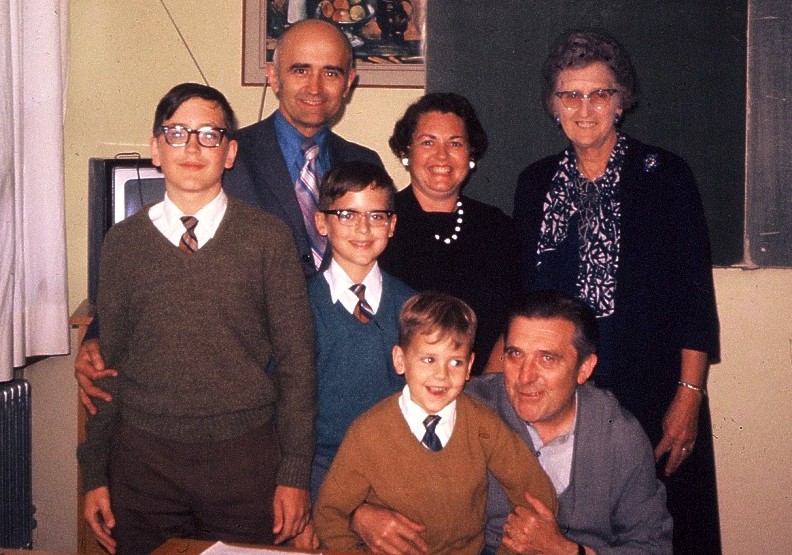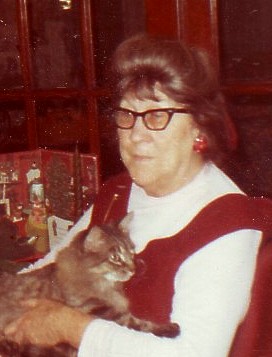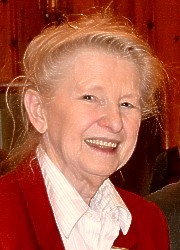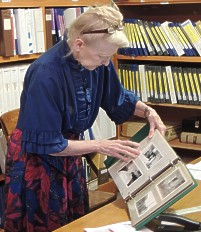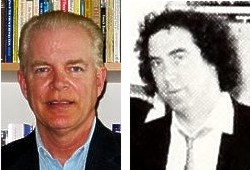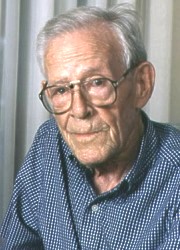As the years passed, many who had been involved in the play or pageant either died or moved away from Morganville.
No one from Fèves visited Morganville. Occasionally, Fèves would receive a visitor from her sister. Often these were young
men from Morganville who were in the military, stationed in Europe as part of America's large force countering the Soviet
contingent behind the Iron Curtain.
An exception was 1971. Dan and Lily Roenigk, their son Ivan, Ivan's wife and their three sons stopped in Fèves while
traveling in Europe to visit the family's ancestral home. Henri and Mathilde were their hosts and provided a personal tour
of the village.
Part of the Dan Roenigk family visited Fèves in 1971. This photo was taken in the Torlotting home. Rear, l-r: grandson Richard, son Ivan, grandson Dale, daughter-in-law Wilma and wife Lily; front: grandson Donald held by Henri Torlotting
The years after the war were not kind to Carson. Small towns can be nurturing for a person who fits in, but difficult
if a person doesn't. Some townsfolk looked on her with admiration, while others saw her as someone who didn't belong.
When the local Methodist church was being remodeled, one group sought her advice on colors. That same group was forced to
claim they had made the selections, for they knew many in town would reject the choices solely because Carson was involved.
In an August 1948 letter to her daughter, Carson wrote, "I want to go to New York. There are many reasons ... I may
leave this fall to go someplace to work."
But after visiting college-time friends in the East, she said, "Oh, but darling, I don't ever want to live here again. I'd
like to come here to shop with a handful of money and see the shows. ... [but] I want to live where I can walk to town."
The New York Carson remembered had vanished during her absence. America's large cities, once filled with people who grew
up on farms or in small communities, were increasingly populated by city-raised people. Television's growth made it
increasingly difficult for magazines to survive. Newspapers focused more on international events. So Carson found it
difficult to sell her stories about a time that had passed. It didn't help that her interest turned more to poetry, an
area even less commercially rewarding.
In 1978 at age 82, after having wrestled with a variety of health problems, Carson moved to Ithaca, New York, to make
her home with her daughter Cynthia and son-in-law Gould Colman. The Carson home was sold and moved out of Morganville.
Velma Carson in 1979
The preservation of the sister-city story had never been a high priority for Carson, although Colman once stated he thought it represented her greatest achievement.
But Roenigk's death in 1981 would trigger events that would both help preserve the story and once again shine a light on the
then-faded tale, albeit briefly.
Cathy Haney, who along with parents Joe and Josephine, had driven from nearby Broughton to be at the show in 1948, would be a
key figure in its revival. Broughton would also play an important role in what was to come.
In 2015, Haney described why she and her parents were interested in the play and how they came to know Carson.
Cathy Haney
I was eight years old the night we attended the pageant in Morganville. I didn't really understand what was going on,
but I was impressed - impressed enough to remember and ask questions over the years. My folks discussed the pageant many
times and all the work that went into it. Both of my parents were "Longfellow" fans. My Dad could quote pages of the "Song
of Hiawatha". Since the narration for the pageant was set in that meter, it interested him, to the point he could tell you
how the script was following the original song.
Sometime in the early 1960's, a friendship between Joe, Josephine and Velma developed. After all, we were part of that
out-cast group, not only in Clay County, but in the state of Kansas. We were Democrats!
They enjoyed discussing politics, literature and especially poetry. I went along for the ride. Over the years, I got to
know Velma better. I would ask about the pageant and get a few answers, mostly about finding costumes and what a success
the evening was. By the time I started asking questions, it was over twenty years after the fact and people just weren't
interested.
One day, I was sitting on the bed in Velma's room ... As I sat there on the bed, I glanced down and there on the floor was
a stack of papers, titled "Message to Feves." I picked it up and asked, "Is this what I think it is?" "Yes, and you put
it back!" she replied. I folded the paper and stuck it in my jacket pocket.
By 1981, Haney's interest in local history had led to her becoming the curator of the Clay County Historical Society museum. She
had long been interested in the pageant and the sister-city relationship, but local interest had largely waned.
She described what happened next.
Then another resident of Morganville, Dan Roenigk, died. ... His son and daughter came back to break up the family
home. They were history-minded and began to bring items to the museum. One day, Ivan, Dan's son, walked in with a box
of stuff and started to unload it. He pulled out a notebook and said, "I don't think you will be interested in this."
I almost fell across the table grabbing for the book. It was titled "Message to Feves." Inside the scrapbook were
pictures of the pageant, newspaper clippings, and letters from people in Feves. It was a treasure.
Haney with Roenigk's scrapbook
Haney was presented with an opportunity to retell the story a few years later. In a July 6, 1996 article in the Salina (Kansas)
Journal, she said, "The story of Morganville and Feves was almost forgotten when a group of school children toured the Clay County
museum in 1990."
The tour was complete and the children were waiting to return to school. Haney happened to overhear one of the children
comment, "Nothing ever happened around here" - meaning nothing that really had any importance outside the boundaries of Clay
County. That was her cue to relate the story.
But she wanted an opportunity to retell the story to a bigger audience. That opportunity was presented two years later in
1992. As she described in 2015:
Time passed. Katie Armitage, who was doing research for the Kansas Humanities Council, stopped by the ... museum looking for some information. After we talked a while, she wanted to know if there was anything in the community that might be a humanities program. I thought a while and cut loose on Feves. When I finally shut up, she said to apply for a grant.
The proposal was submitted that same year with the title "Beyond Our Rim: Morganville, KS, Feves, France and UNESCO's Marshall Plan 1948-1952."
Haney was told it would be wise to involve people who would be viewed as being authorities on the subject. So she
enlisted the help of Professor John Daly from the Kansas State University history department and Professor John Sweets
from the Kansas University history department.
The real work began when she learned her proposal had been approved.
Professors Sweets (left) and Daly
Haney envisioned a narrated slide show based on the materials in the scrapbook. It would be supplemented with anything
additional she could locate. She used her experience with the school children in 1990 as a device to introduce the
retelling of the tale.
One resource was the people in Morganville. A June 2, 1993 Salina Journal article announced a program that Haney hoped
would bring in some artifacts of the pageant.
MORGANVILLE - A meeting is planned Thursday to discuss a post-World War II project between this Clay County town of
about 200 and Feves, France.
The Clay County Museum has received a grant from the Kansas Humanities Council to research the project, which linked the
two towns through Operation Democracy Inc., an effort based on the Marshall Plan concept of sending bread instead of
bullets to Europe. ...
Slides taken the night of the pageant will be shown at Thursday's 7:30 p.m. meeting at Morganville City Hall. Anyone with
memorabilia from the Morganville-Feves project is asked to take it to the meeting. Grant funds will be used to make a
slide program on the project.
One of the first people Haney wanted to contact was Lafe Todd. She didn't have to look hard as he was still living in
Clinton, New York, where he had retired from Hamilton College 12 years before.
Todd responded to her letter with several of his own. His July 9, 1993 letter gives additional insight into Operation
Democracy and his affection for Morganville and its driving force, Velma Carson.
He began by asking Haney that she "put up with my 81 year old typing and my 30 yr. old portable," adding, "I am a
computer impaired person."
Todd in 1993
At the risk of sounding a bit cocky, I'm afraid I more or less "invented the Sister City" notion back in 1946 -
although something like it had occurred briefly during the war when a couple of American cities, working with Natalie
Payne's "Bundles for Britain," "adopted" several English cities for relief purposes during the bombings. [They sent]
food, nylon stockings, medicine etc. When I left the Army ... [I] stepped into the job of National Campaign Publicity
Director for American Aid to France, Inc. - Hon. Chairman, General Eisenhower ...
In order to launch a "grass roots" effort, I suggested that my old home town, Dunkirk, N. Y., stage an all-out relief and
good will gesture toward its namesake city of Dunkerque, France. The town went nuts, and achieved world wide publicity ...
A.B.C. radio provided a two-way radio broadcast between the two cities, MCed by Charles Boyer and French Ambassador,
Henri Bonnet. The Voice of America sent it around the world, and the French Press gave it the works. Anyway, about sixty
U. S. Cities almost immediately followed suit ... My reaction was "What in hell hath Todd wrought?" We were deluged with
French mayors looking for their towns to be adopted.
After the A.A.t.F. campaign ended ... I was invited by Isabella King (former Congress woman from Arizona, and Eleanor
Roosevelt's dearest friend and bridesmaid) to do publicity for ... "Operation Democracy, Inc." ... We were to "tell the
American story overseas," "win friends and influence people," as well as bring about Wendell Willkie's "One World!" Great
days of hope and promise for Henry Luce's "American Century!" One of the best of all was dear little Morganville, KS. ...
and, of course, Velma Carson. What a gal!
I went from "O.D." to the U. S. Information Agency in 1950 as "Chief" of the Office of Private Enterprise Cooperation, the
N.Y. City's unit supplying stories from the "Heartland" of America for U. S. I. A.'s radio, publications, motion picture
divisions' etc. One of my main preoccupations continued to be "sister cities," with the emphasis on "Getting to Know You"
and beating the hell out of the Iron Curtain and Joe Stalin. Little did I know how long it would take!
Haney asked Todd if Morganville was the smallest American city to adopt a European sister. Todd said he believed it was,
recalling Chester, N. Y. with a population of about 1,200 as being the next closest.
He added that Chester had adopted Kumrovec, in Croatia. It was the home town of Marshall Tito, who was the leader of
Yugoslavia, a confederation of states that included Croatia. Todd said Chester "was deluged by pen-pal letters from
school kids - full of Communist propaganda praising their glorious leaders."
Haney also reached out to Fèves and exchanged letters with then-mayor Patrick Hug.
Former Fèves mayor Patrick Hug


